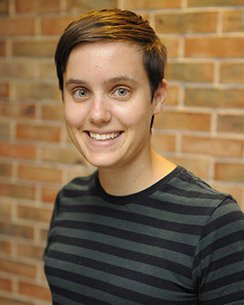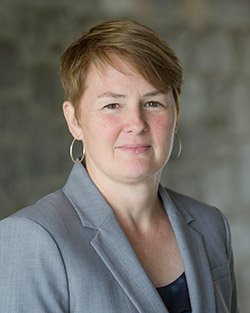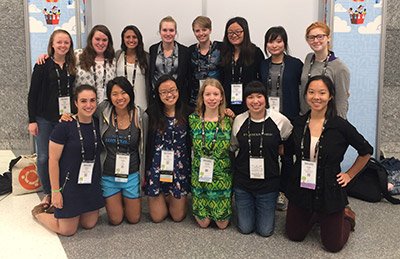For one student, it started in childhood, as her well-intentioned parents steered her to creative writing and journalism, her brother to coding and leadership camps.
For Anna Jensen ’17, it crystallized this summer through her Silicon Valley internship, when men at networking events would assume she was doing product design or marketing — because “women who wear makeup don’t code.” Or, they’d quiz her on some obscure programming language, like the hipster who sees someone in a Ramones shirt and challenges them to name two of their albums.

“There was a real need for a group like this,” says WiCS co-founder Chloe Stevens '13, a site reliability engineer at Google.
For others, like Rachel Diamond ’18, it hits home when looking into engineering companies, many of whose software engineer ranks are less than 20 percent female. For Chloe Stevens ’13, now a site reliability engineer at Google, it’s all the time.
“Being constantly asked if I’m a recruiter, or in H.R., or someone's assistant, and then being met with shock and awe when I reply that I am, in fact, an engineer, does not exactly inspire feelings of confidence and belonging,” says Stevens.
“You just get worn down,” adds Jensen, “constantly trying to justify why you deserve to sit at the table with everyone else.”
Pushing back on that narrative, though, is Swarthmore’s Women in Computer Science (WiCS), a student-run group that fosters an inclusive and supportive community to boost representation of women in the discipline on campus and in the real world. The club’s ascent dovetails with the growth in the number of female students among computer science majors at Swarthmore — which, at 36 percent, is twice the national average.
“We have an amazing group of women teachers and students who have created this supportive community,” says Gabriela Brown ’18, one of the WiCS members determined to disrupt barriers to computer science.
“I want to share the confidence and passion I’ve found in computer science with other women.”
'That Feeling of Impossibility'
Jensen got the bug at age 13, cascading into CSS to build “the most painfully bright and flashy” layouts for her MySpace page.
Brown first got it in high school, seeing how much fun her friends had programming and taking an intro to computer science class online. “I loved it!” she says. “I found myself absorbed in the neat, logical puzzles for hours without realizing how much time had passed.”
But for many other students, even Silicon Valley native Laura Chen ’19, the thought of one day pursuing computer science didn't materialize before they came to Swarthmore.
“It often felt like peers who coded were people who were inherently talented and had been doing it for most of their lives,” says Chen, an economics major and computer science minor from Fremont, Calif. “It was scary to start coding. It felt like the barriers were too high.”
One way or another, though, they found themselves in the intro to computer science course (CS 21) at Swarthmore. For Melissa O’Connor ’14, it was friends convincing her to take it because she thrived at puzzles. For Stevens, it was being lotteried out of the history seminar she wanted to take and having a fortuitous talk with Associate Professor and Chair of Computer Science Tia Newhall.

“One of the things I tell students is that a computer is a universal machine," says Professor of Computer Science Lisa Meeden, who joined the faculty at Swarthmore in 1994.
The department has made efforts to raise the accessibility of the course over the years, as more and more students from all backgrounds view the basics of computer science as a crucial skill set to have in this era of Big Data.
“One of the things I tell students in CS 21 is that a computer is a universal machine," says Professor of Computer Science Lisa Meeden, who joined the faculty at Swarthmore in 1994. "If you can correctly describe what you want to accomplish in a program, the computer can make it happen. So being able to think algorithmically and write programs is an incredibly useful tool, regardless of which discipline one decides to pursue.”
Once Meeden learned how to program, taking computer sciences courses as part of her mathematics major, she was hooked. Many of her Swarthmore students have similar stories.
“I love the combination of creativity and logic involved in figuring out how to write a program that will work in a certain way,” says Diamond, a computer science major from Winchester, Mass., and co-president of WiCS, who relished the CS 21 course.
It clicked for WiCS co-president Emily Cai ’18 when she and her lab partner, Maggie Eberts '18, implemented a data structure she likens to a Scrabble cheater, organizing an entire dictionary of words to output the many combinations of words at one’s disposal.
“Many hours were spent on that project,” says Cai, a computer science and engineering major from Edison, N.J., “but watching it all come together was well worth it.”
For others, it was the “maze” lab, in which the student tries to escape from Parrish (figuratively) by cracking the codewords for each staircase. Or it may have been a breakthrough off campus, such as Chen’s experience at the all-women hackathon FemmeHacks in Philadelphia last winter.
“Coding a semi-functioning Chrome extension from scratch by the end of a night probably ranks in the top 80th percentile of euphoric moments in my life,” says Chen.
“It’s that feeling of impossibility in the beginning, followed by breaking each problem down into smaller and smaller steps until one is small enough to tackle,” she adds. “Then, at some point, things stop breaking and you start working, and you realize you’ve built a parallelized Game of Life, or a movie player that can play an ASCII version of Star Wars backwards.”
Systems of Support
Newhall, herself, never envisioned a career in computer science. But a tight job market for math teachers led her to seek another certification, and by 1999 she was teaching computer science at Swarthmore. Back then, there were three tenure-track professors and 12 students with computer science majors. (Today, the department will soon add an eighth tenure-track professor, and there are 115 computer science majors and 36 minors among juniors and seniors.)
Newhall and Meeden started a club for female computer scientists in the early 2000s, but it lacked a critical mass. So began their conscious effort to foster an inclusive and supportive environment for all students.
“A student from an underrepresented group will feel more hooked into things if the culture is friendly, welcoming, and supportive,” says Newhall.
Several alumni and current students credit the department for putting or keeping them on a path of computer science. For Brown, it’s the atmosphere: “very open, welcoming, and intellectually driven.”

This year, 14 students attended the Grace Hopper Celebration of Women in Computing in Houston, Tex.
“I can walk into any professor’s office with questions and curiosities,” says the computer science major from Mountain View, Calif., “and they are more than willing to help.”
But the faculty are keenly aware of the value of peer support, as well. They instituted the “ninja” program, where student mentors assist class and lab sessions and run study groups. They also host internship and research panels to help students determine career paths and departmental lunches at which faculty and student mentors help students with course selections. The faculty also keep the computer labs open 24 hours, recognizing that “a lot can go on when we’re not here,” says Newhall.
Students are supported off campus as well, as the department funds travel to opportunities like the Grace Hopper Celebration of Women in Computing. This year, eight students received funding to attend Grace Hopper, from the department, the Dean's Office, and the College's Howard Hughes Medical Institute (HHMI) grant program, and another six attended with external support. O’Connor attended the celebration as a co-president of WiCS while at Swarthmore and returned last month as a software engineer for FactSet Research Systems.
“That experience really shows you the problem areas in computer science,” she says, “and how big the gap between male and female software engineers really is.”
A Place of Encouragement
Over the years, female computer science students found success at Swarthmore and at national conferences. But their representation in the department remained low, with as few as one or two women in any given course. Stevens and a friend met with juniors and seniors in the department who had envisioned a club like WiCS, fleshed out the concept, and had it officially chartered in 2013.

““A student from an underrepresented group will feel more hooked into things if the culture is friendly, welcoming, and supportive,” says Associate Professor and Chair of Computer Science Tia Newhall.
“There was a real need for a group like this,” says Stevens. “Somewhere that people could meet each other, make friends, and generally feel less isolated.”
It’s a place for learning and asking questions and receiving encouragement, where students get the tools and training for potential careers in computer science, says Diamond. The group holds workshops on resumes and job interviews, coordinates with Career Services to direct students to job opportunities, and invites alumni (most recently, Cathy Polinsky ’99, chief technology officer and head of engineering and product at Stitch Fix) and other industry professionals to come and give students a glimpse of a career in computer science. It has also established a student-alumni mentorship program, to put students in direct contact with professionals from the field.
Other benefits are more technical, from sending students to coding conferences and events like FemmeHacks and WECode to exposing them to the principles of hardware hacking and web development. But for many students, the real benefit, the heart of WiCS, is intangible.
“I go to WiCS meetings because it’s a community of women who can empathize with you,” says Jensen, a computer science major from Timonium, Md., who will work as a software engineer at Flipboard after commencement.
“There’s no dismissal, no doubts about your experiences, and no assumptions about your technical knowledge or skill,” Jensen adds. “WiCS gives us an empowering community to relax our guard on these things.”
It’s that community on which WiCS members will look back fondly — the late nights of the faces bathed in the monitors’ blue glare, the clacking of the keyboards, the classmates popping in and out. And it’s in that spirit that they can envision a more inclusive field for the next generation.
“Don’t let the stereotypes of who a programmer is ‘supposed to be’ deter you,” advises Brown, “because it doesn’t reflect the diversity that already exists in the industry, or the ability that you have to define what it means to be a programmer.”










